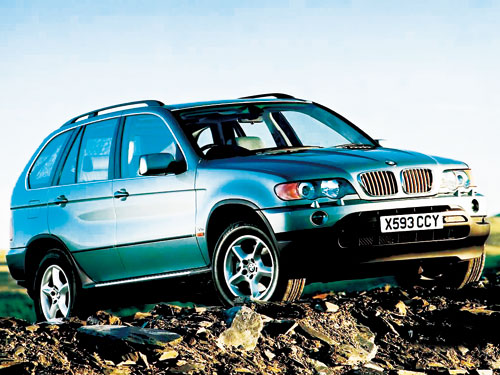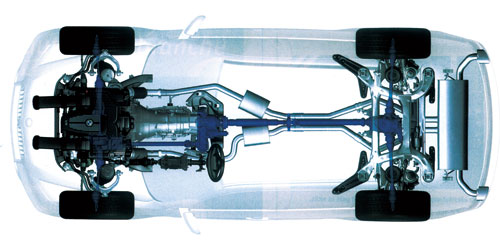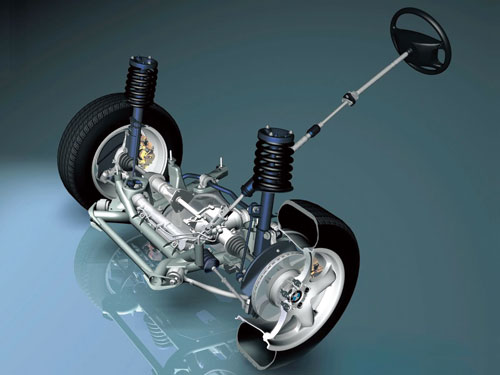为了更好的动态性能,宝马做了这些创新

宝马 X5系列轿车不仅适合在公路上行驶,也适合于越野行驶
在主动式转向助力器和大量相互联系的驾驶辅助系统的帮助下,宝马 X5系列轿车的动态性能得到了很大提高。他们给这款四轮驱动的汽车取了一个新的名字——SAV(运动休闲车),而没有沿用SUV(多功能运动车)的概念。
在第一版宝马X5系列轿车中,就已经把动态性能作为这一种四轮越野车的重要设计要求了。与四轮驱动系统和较大的最小离地间隙相匹配,X5系列轿车有着动态行驶性能非常好的行驶系统。宝马的设计人员甚至对SUV多功能运动车的设计数据也提出了抱怨,从而创造了新的SAV运动休闲车的概念。
在后续的几款样车设计中,行驶机构的设计师们采用了单轮独立悬架结构和可调节的四轮驱动变速器。X5的前轮安装在双横平行摆臂悬架前桥上,由宝马公司申请了专利保护的后桥集成了驱动和减振系统。车轮和车轴头以及4个转向拉杆承受着传导到悬架中的振动,并把这些振动载荷分解为纵向力和横向力分别传导出去。安装在前桥上的减振轴承进一步提高了车轮滚动时的舒适性。
宝马X5系列轿车还可以选配与5系列、7系列轿车一样的主动式转向助力器。这种由宝马公司和采埃孚公司共同研发成功的助力转向技术在齿轮齿条转向机构的基础上增加了一套复式行星齿轮传动机构,相当于增加了第二套利用电动机辅助的转向机构。它产生一个辅助转向力矩,经行星齿轮传动机构传递到转向机中,控制着车辆的前轮按照实际需要增减转向角。在它按一定的传动比辅助转向的同时,普通的转向机构始终在执行着转向控制任务,并受到主动式转向机构的控制调节。在泊车时,方向盘旋转的角度相同时,车轮旋转的角度明显大于在高速公路上行驶时的转向角。这样一来,在泊车时驾驶员就可以不用拼命地打方向盘;另一方面,也提高了X5轿车在高速行驶时的动态稳定性能。
主动式转向助力器
X5系列轿车的主动式转向助力器在车速90km/h以内时直接发挥作用。当车速高于90km/h时,它采用“间接”的方式发挥作用,有利于高速直道行驶。当制动操作比较困难时,它对车辆的行驶稳定器给予大力的支持。它利用电动机发出的反向转向控制信号校正着车辆的行驶状况,防止偏离车道。
同样,用户也可以为X5轿车选购集中控制车辆行驶稳定器和减振器的自适应驾驶系统。控制指令的基础是有关速度、转向角、纵向加速度、横向加速度、车身加速度和车轮加速度等数据。其摆动控制电动机控制着宝马7系列轿车的摆动平衡稳定系统,经减振器的电磁阀保持车架的平衡,根据不同的行驶状况调节着车辆行驶舒适性或动态行驶性能。
驾驶员利用自适应驾驶系统可以在运动式和舒适性两种驾驶方式中任选一种作为基本驾驶方式。由于这一控制任务要求的数据量相当大,因此宝马公司成为世界上第一家利用Flexray总线系统传送大量数据的汽车生产厂。
底盘管理系统
X5系列轿车的底盘管理系统将驱动4个车轮的X-Dirve系统、DSC动态稳定程序系统、发动机控制器和可选的主动式自适应转向控制系统等连接成为一个统一的行驶动态性能控制网络。DSC首先确定了4个车轮驱动力的分配,控制着各个车轮的制动和发动机工况的管理,保证它们之间的工作相互匹配,以便在任何时候都为车辆提供最佳的行驶动态性能和最高的行驶安全性能。
X5系列轿车在制动时,采用的是内部风冷的刹车盘。在4.8i级的高级X5轿车中,前刹车盘直径为365mm,后刹车盘直径为345mm。
与其他的汽车生产厂家一样,宝马公司在X5系列轿车中也对DSC系统的功能进行了扩展,除了基本的功能,如ABS、侧滑监控之外,还增加了挂车稳定性监控功能、下坡行驶辅助功能、弯道刹车辅助功能和电子差速锁、可变防滑轴差速器等的监控功能以及车轮空转自动制动功能。能够自动生成最大制动力的制动辅助系统同样也安装配置在X5系列的轿车中,它具有制动力衰减功能,可以在极高的制动摩擦温度时有目的地调节制动力。
其他DSC系统还包括干式制动功能、车辆启动辅助功能和机电驱动、液压驱动的泊车制动功能。按照宝马公司给SAV型车辆的定义,X5轿车对整个驱动进行着有力的运动性能监控。可以通过简单的按钮选择对发动机进行控制或者对制动系进行控制,使X5轿车的驾驶员可以方便地根据路面情况(沙土路、烂泥路面或冰雪路面)轻松地行驶。
跑车扁平轮胎
X5系列轿车首次配备了跑车扁平轮胎。即使是在轮胎完全没有气压的情况下,X5仍然能够以不超过80km/h的速度继续行驶150km。轮胎的规格为255/55,18″(45.7cm)的轮辐,根据客户需求还可以选配19″(48.3cm)和20″(50.8cm)的轮胎。
在对跑车扁平轮胎的气压监控中,依据的是ABS装置提供的各个车轮旋转次数的监测比较数据。它的监控依据是:当轮胎漏气较多后,车轮的旋转次数会发生变化;当车轮轮胎的气压低于要求的气压数值30%之后,车内的仪表盘中就会出现报警提示。

宝马X5系列轿车中的典型机构是申请了专利保护的集成了驱动和减振系统的后桥
For a Better Dynamic Performance

Intelligent BMW X-Drive all-wheel-drive technology standard
The new BMW X5 remains sure-footed and agile in every situation and on every surface thanks largely to BMW's intelligent, full-time xDrive all-wheel-drive system. Under normal driving conditions, drive forces are spread out front-to-rear in a 40:60 split. Reacting extremely quickly and precisely, xDrive ensures variable power distribution front-to-rear as soon as a specific driving situation or surface conditions require.
To perform this function, BMW xDrive features a center differential with an electronically controlled multiple-plate clutch which feeds the power of the engine to where it can be used to best effect. Hence, this all-wheel-drive system, which was introduced by BMW, offers a level of security in spirited driving. It works to counteract any over- or understeer in bends immediately by moving power to the front or the rear as required to help stabilize the vehicle.
BMW xDrive supports yet another feature typical of the BMW X5 by ensuring maximum traction on difficult surfaces. Here again, variable control instantaneously shifts drive power to the axle with better grip thereby ensuring maximum stability and traction under all circumstances.
These many qualities of BMW's electronically controlled all-wheel-drive system give not only the BMW X5 and X3 SAVs, but rather all BMWs equipped with xDrive truly outstanding driving qualities at all times. The system is recognized as so beneficial that BMW has now become the world's most successful manufacturer of all-wheel-drive vehicles in the premium segment.
Integrated chassis management for optimum control quality
To distribute drive power quickly and with maximum precision, xDrive all-wheel drive, DSC, engine management and Active Steering are all networked with one another via Integrated Chassis Management, which ensures an optimum balance of drive power distribution, individual application of the brakes on each wheel, and engine management.
This symbiosis of fully harmonized suspension and chassis management sets the foundation for driving dynamics and active safety of the highest all-round standard.
DSC with new functions, faster and even more precise hydraulic control
Boasting an even higher standard of performance for optimum comfort, convenience and function, Dynamic Stability Control on the new BMW X5 makes a particularly important contribution to safe and active driving. The basic functions of the overall DSC system include ABS brakes, Automatic Stability Control, Dynamic Stability Control, Hill Descent Control, Dynamic Brake Control which maximizes brake pressure whenever required for particularly powerful deceleration, Cornering Brake Control which helps to prevent the vehicle from "turning into" a bend when applying the brakes lightly and – as the name implies – Trailer Stability Control.
Automatic Differential Brake, another highly sophisticated electronic system, helps keep the driver in control by automatically applying the brakes on a wheel about to lose traction.
BMW's new DSC system further enhances safety through various additional functions. First, Brake Fade Compensation works to counteract any decrease in brake power at extremely high temperatures by increasing brake forces accordingly (anti-fading support). Brake Standby provides a moderate build-up of brake forces in emergency situations which may require sudden deceleration. Brake Drying, as yet another example, optimizes the performance of the brakes in the wet, while the start-off assistant makes it easier to start off on an uphill grade. The parking brake of the new X5 uses both an electro-mechanical and hydraulic function activated or released at the touch of a button.
Dynamic traction control for greater spin and more dynamic performance
Reflecting its high standard of driving dynamics, the new BMW X5 also comes with Dynamic Traction Control. All the driver has to do to activate the DTC mode is press a button on the center console. This raises the threshold for intervention of the engine and brakes by DSC, allowing the BMW X5 to set off smoothly on loose snow or sand with the drive wheels intentionally spinning slightly. Last but certainly not least, DTC promotes an even more sporting and active style of driving by allowing more wheel-spin before intervening.
The high-performance brake system in the new BMW X5, supported by the wide range of new DSC functions, ensures excellent stopping power in every situation. Vented discs on all four wheels ensure maximum braking efficiency.
Brake disc diameters on the BMW X5 3.0si are 13.1 inches in front and 12.6 in the rear. On the X5 4.8i, in turn, the corresponding measurements are 13.7 and 13.6 inches respectively.
First SAV featuring runflat tires standard
The new BMW X5 is the first vehicle in its class with runflat tires standard. These tires, which are mounted on extended hump rims, are the fourth generation of runflat tires. Runflat tires allow the driver to go on driving even after a complete loss of tire pressure. The driver can continue up to 90 miles at a speed up to 50 mph even with the vehicle fully loaded.
Both models of the new BMW X5 come standard with 18-inch light-alloy wheels with 255/55 all-season tires. Larger 19-inch light-alloy wheels with all-season tires are included with the optional sports package. On the X5 4.8i with Sport Package, 20 inch wheels with 275/40 front and 315/35 rear performance tires may be ordered. Here again, the tires are runflats.
The standard Tire Pressure Monitor warns the driver of a gradual loss of air pressure. Consistently monitoring actual tire pressure, this system registers any deviation from normal pressure. A graphic symbol in the instrument cluster display informs the driver whenever the system detects a loss of pressure.















获取更多评论